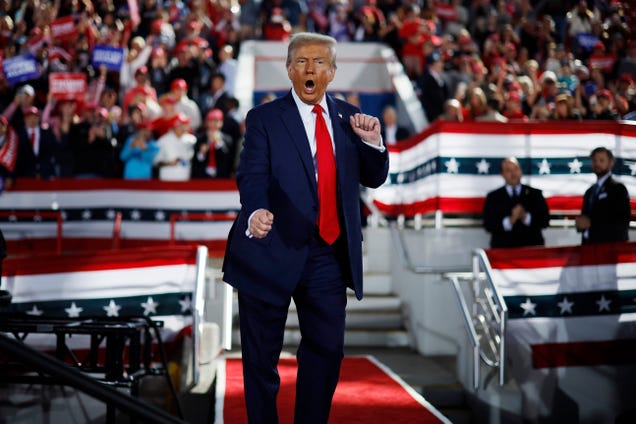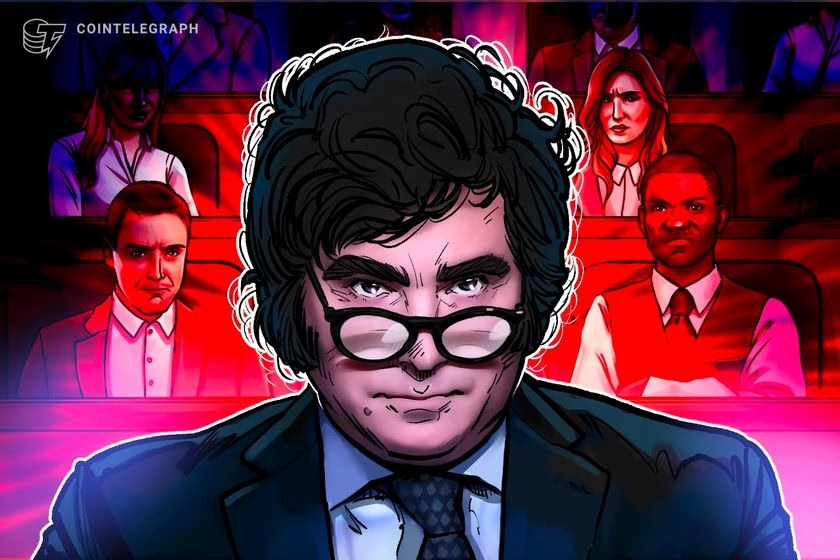Get ready for Donald Trump’s economy

Top Stories Tamfitronics
A version of this article originally appeared in Quartz’s members-only Weekend Brief newsletter. Quartz members get access to exclusive newsletters and more. Sign up here.
It’s the question everyone is asking: What happens now? Donald Trump is on his way to the White House, and by January, he’ll have a team in place to begin implementing the economic policy he’s been touting for months: tariffs on all imports, lower corporate tax rates, extending his 2017 tax cuts, reducing regulation of cryptocurrencies and banks, ending taxes on tips and Social Security, and possibly eliminating income and payroll taxes.
Trump says all this would end inflation, boost manufacturing and employment, and lower the cost of food and housing. But that has been analyzed and dismissed by almost every economist and trade group in the country to look at it.
“Trump has again proven he is a brilliant huckster,” said Kristen Monroe, a political economist at the University of California Irvine. “The election was decided because Americans thought Trump would do a better job managing the economy. Unfortunately, they are wrong. Trump’s policies will help billionaires like Elon Musk but hurt most everyday Americans. We’ll see higher prices, increased deficits, increased costs for healthcare and prescription drugs, and trade wars that will hurt everyone.”
The head of the U.S. Chamber of Commerce denounced both Trump and rival Kamala Harris as “anti-trade” in an interview last month with Bloomberg. But the group has largely been shy about criticizing Trump openly.
It wasn’t so risk-averse in 2018, when it slammed Trump’s China tariffs during his first term. “Tariffs are simply taxes that raise prices for everyone,” then-Chamber CEO Tom Donohue said at the time. “Tariffs that beget tariffs that beget more tariffs only lead to a trade war that will cost American jobs and economic growth.”
Economists say Trump’s proposal now — for tariffs of 50% to 60% on imports from China and 10% to 20% on all other imports — would crush the economy and do little to preserve jobs. A Bloomberg Economics analysis found that Trump’s tariffs would almost double inflation from its current rate of near 2% to 3.7% by the end of 2025.
In one notorious example of a tariff Trump imposed the last time he had the Oval Office, a levy was slapped on imported washing machines to protect Whirlpool, which argued that competition from Korean manufacturers Samsung and LG was harming domestic manufacturers. But according to the conservative Heritage Foundationall the tariff did was hurt consumers, boosting the price of washers by 12%, or almost $100 per unit. “In total, consumers have paid an additional $1.5 billion annually in higher prices, which far surpasses the $82 million made in tariff revenue,” the group said in a report. Their conclusion: “We shouldn’t rinse and repeat when it comes to costly washing machine tariffs.”
The National Retail Federation warned that U.S. consumers could lose $46 billion to $78 billion in spending power each year if Trump imposes new tariffs. “A tariff is a tax paid by the U.S. importer, not a foreign country or the exporter,” NRF’s Jonathan Gold said. “This tax ultimately comes out of consumers’ pockets through higher prices.”
Farmers’ fears
Even farmers are scared. The Institute for Agriculture and Trade Policy warned that Trump’s plans for broad new tariff measures will “likely spur retaliation among key trading partners, creating chaos for a farm economy reliant on export markets.”
A joint letter by almost two dozen Nobel-winning economists warned in the closing days of the campaign that Trump’s proposed high tariffs, “even on goods from our friends and allies and regressive tax cuts for corporations and individuals, will lead to higher prices, larger deficits, and greater inequality.”
Multiple studies, including one from the right-leaning Peterson Institute for International Economics, show that tariffs won’t bring in even a fraction of the amount of revenue the U.S. Treasury gets from taxes on personal and corporate income, crippling the budget, and leaving no money to fund voters’ favorite programs, including Social Security, Medicare, and veterans’ benefits.
Worrisome tax cuts
Trump’s tax cuts are even more worrisome. Cutting taxes on tips would reduce the payroll taxes collected, lowering the Social Security payments that restaurant servers and bellhops could collect when they retire. Lowering corporate income taxes has never actually trickled down to wage earners, or even investment in new factories, as the Center on Budget and Policy Priorities noted in a recent study. And while the cuts will surely send stocks surging, as corporations book greater profits, all that does is make people who own stocks that much richer.
Those tax savings did not translate into higher wages, new jobs, or more investment last time. They were used instead for stock buybacks and high-priced buyouts of competitors, making options-holding executives and other shareholders richer, and reducing competition and its effect on lowering prices. And U.S. companies already pay among the lowest effective tax rates in the world. A recent study by the Institute for Taxation and Economic Policy found that America’s largest, consistently profitable corporations saw their effective tax rates fall from an average of 22% to an average of 12.8% after the Trump tax cut took effect in 2018.
The institute’s October study of Trump’s personal income tax proposals found that if they are in place by 2026, the richest 1% of Americans will receive an average tax cut of about $36,300 and the next richest 4% will receive an average tax cut of about $7,200. All other groups will see a tax increase, with the middle 20% paying an extra $1,500 in taxes and the lowest-income 20% seeing their tax bill rise by almost $800.
Even before stepping into the White House again, Trump’s plans have the Federal Reserve trembling. On Thursday, after the Fed lowered interest rates by a quarter of a point, Fed Chair Jerome Powell felt compelled to tell journalists at a news conference that while the economy has been doing well, policies adopted by the White House or Congress could force the Fed to change course. “We don’t think it’s a good time to be doing a lot of forward guidance,” Powell said.
Powell also had an implicit warning for Trump, that he can’t starve the Treasury and keep spending.
“The federal government’s fiscal policy is on an unsustainable path. The level of our debt, relative to the economy, is … unsustainable. And we see that,” Powell said. “You’ve got a very large deficit, you’re at full employment, and that’s expected to continue. So it’s important that [the debt-to-income ratio] be dealt with. It is ultimately a threat to the economy.”
And Powell made clear that the Fed is determined to maintain its statutory independence from Congress and the Presidency. Asked if he would step down if Trump asked him to, Powell, who was nominated by Trump, said “No.” Asked if Trump could fire or demote him, he replied tersely: “Not permitted under law.”
“We don’t know enough about the fiscal policy details yet, but with what’s been said previously by the incoming administration, and the hawkish cut we just got from the Fed today, we should all be tempering our rate cut expectations for next year,” said Tim Mahedy, chief economist at Access/Macro, an economic consulting firm based in San Diego.
That’s a sentiment echoed by Greg Daco, chief economist at consulting firm Ernst & Young, who said the Fed will probably slow the pace of its expected rate cuts. “Considering the elections’ results, we now assume a rate cut at every other meeting in 2025, for a total of 100 bps [1 percentage point] of easing, down from 150 bps [1 1/2/ points] previously,” Daco wrote in a note on Thursday.
Trouble ahead?
All this spells trouble for the economy, and particularly for homebuyers, said Tyler Schipper, an associate professor of economics at the University of St. Thomas in St. Paul, Minnesota.
“While the stock market has generally been up (with notable exceptions related to renewable energy), other financial markets are reflecting concerns,” Schipper noted in an email. He pointed out that the yield on 10-year Treasury bonds (how much the government pays to borrow money) rose with Trump’s standing in the polls and spiked following his election. This, he said, reflects two related calculations. “First, by estimates across the political spectrum, the Trump agenda will increase the national debt and require vast amounts of additional borrowing.”
Second, Schipper said, the probable trifecta of controlling the presidency and both chambers of Congress further increases the likelihood that Trump can enact his fiscal agenda. “Since the Treasury market is forward-looking, just the specter of increased borrowing can affect household budgets today,” Schipper said. “A higher yield on the 10-year Treasury typically translates to higher mortgage rates. Even if the Fed can continue their rate cutting cycle into next year, higher government borrowing may partially offset how much those changes affect mortgage rates — damping the enthusiasm for rates finally starting to fall.”
The key factors to watch are inflation and unemployment, said Jane Ryngaert, a professor of economics at the University of Notre Dame. She said the Fed will keep eyeing the labor market and consumer credit markets for signs of distress, while also keeping a close eye on inflation and inflation expectations. But the wild card, she said, goes back to those pesky tariffs. “Tariffs would likely raise prices, potentially creating inflation issues again,” Ryngaert said. “But whether and to what extent tariffs will go through,” she added, “I honestly have no idea.”
And no one else does either.
Discover more from Tamfis Nigeria Lmited
Subscribe to get the latest posts sent to your email.



 Hot Deals
Hot Deals Shopfinish
Shopfinish Shop
Shop Appliances
Appliances Babies & Kids
Babies & Kids Best Selling
Best Selling Books
Books Consumer Electronics
Consumer Electronics Furniture
Furniture Home & Kitchen
Home & Kitchen Jewelry
Jewelry Luxury & Beauty
Luxury & Beauty Shoes
Shoes Training & Certifications
Training & Certifications Wears & Clothings
Wears & Clothings
















